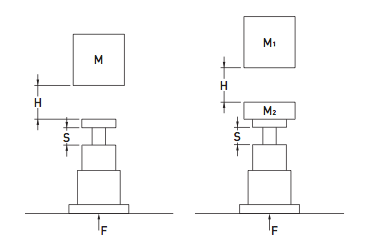Leading the world in
energy absorption

| Design mass for buffer | Ep = Mg(H+S) |
| Maximum impact force |

|
| Design mass for buffer |
 or or

|
| Initial Plunger Velocity |

|
| Multiple Mass Case: | |
| Potential energy to be absorbed Maximum impact force | Ep = M1g (H+S) + M2gS |
| Maximum impact force |

|
| Initial Plunger Velocity |

|
| Buffer design Mass |

|
To avoid confusing conventions within calculations always use SI units in formulae then convert to more appropriate units if required.
| Notation | Quantity | SI Unit |
| M | Mass of body | kg |
| M | Mass of body | kg |
| M | Mass of body | kg |
| Me | Buffer design mass | kg |
| Me | Freefall height | m |
| S | Buffer stroke | m |
| Ep | Potential energy | J |
| v | Velocity | m/s |
| F | Maximum Impact force | N |
| m/s2 | Acceleration due to gravity | g |
| n | Number of buffers in parallel | - |
| ξ | Efficiency | - |
Eg. Consider a body of mass (M1) = 22000kg (22 tonnes) / free falling onto another body of mass (M2) 3000kg (3 tonnes) supported by a buffer.The free fall height (H) being 0.15m. A typical example of this being in catch gear buffers for mine cages where 4 Type 4-114mm stroke buffers are used; this is a multiple mass case.
To find the equivalent energy absorbed:
Ep = M1 g (H+S) + M2 g S = (22000).(0.15+0.114) x 9.81 + 3000 x 9.81 x 0.114 = 60331.5J = 60.3315kJ
To find the maximum impact end force:
F = 661529.6N = 661.5296 kN
To find the equivalent mass for metering pin selection:
Initial plunger velocity
By selecting a Type 4 buffer with a dynamic capacity of 1000 kN these requirements are met.Therefore select metering pin code 05 for masses up to 20000kg (20 tonnes).